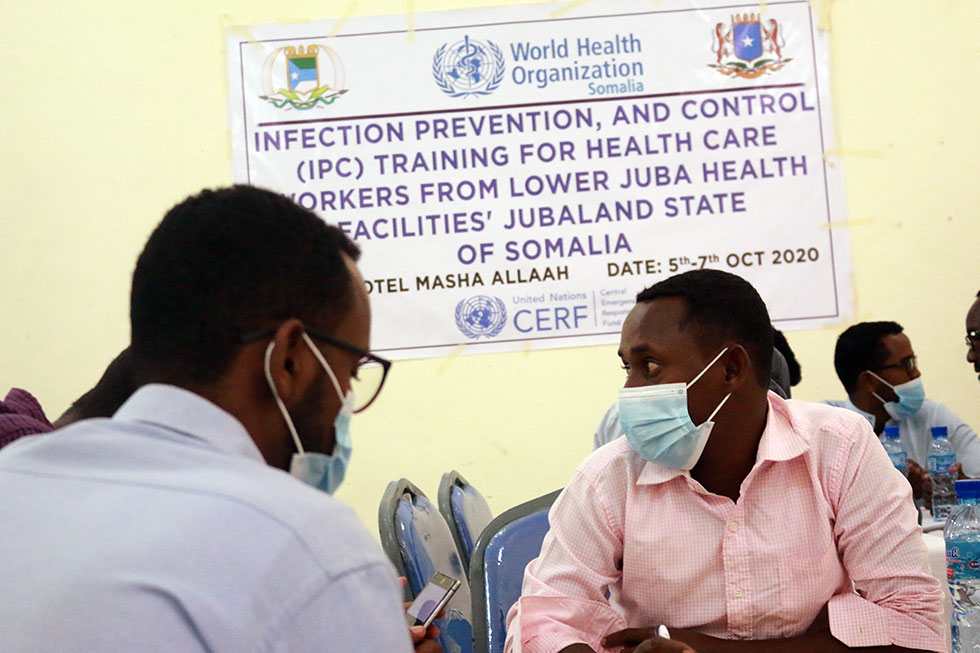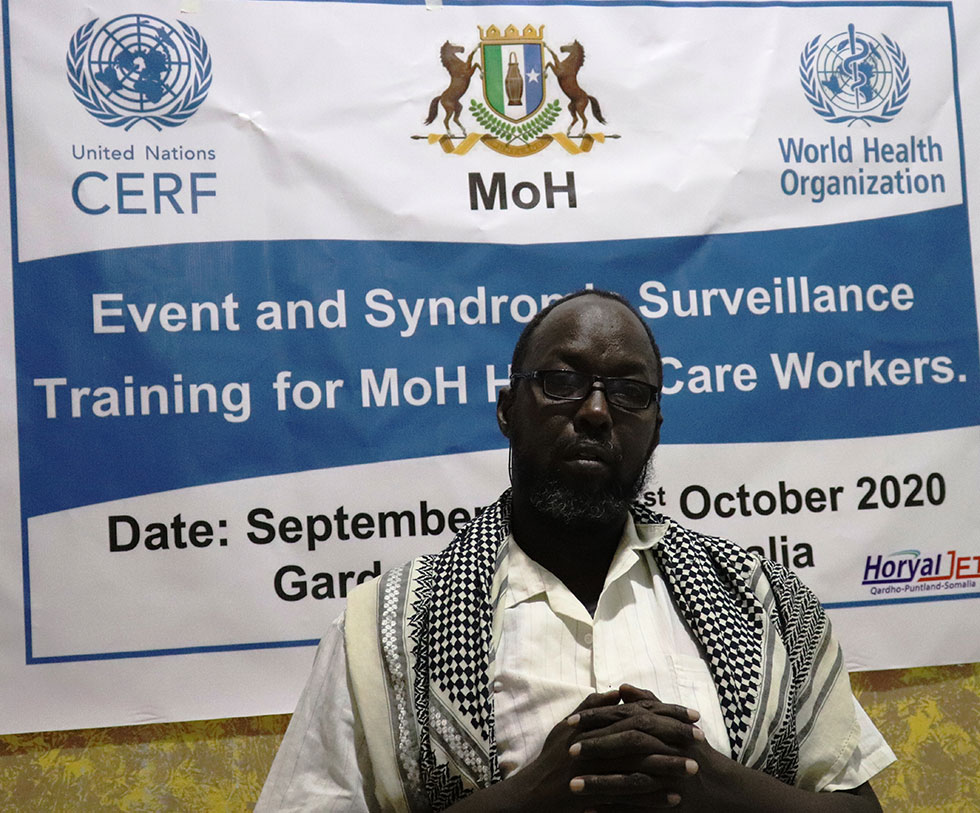 Health workers gaining skills at a training in infection prevention and control, in Jubaland State
Health workers gaining skills at a training in infection prevention and control, in Jubaland State
Every year, the rains gift Somali communities with much-needed water for their animals and agricultural activities. However, in many riverine areas in the south and central States, intense rains result in the Juba and Shabelle rivers overflowing. This causes floods, which destroy homes and roads among other assets and infrastructure, and exacerbate the spread of water-borne and vector-borne diseases, such as cholera and malaria.
During the first half of this year, flooding from the Gu rains affected around 919 000 people, 412 000 of whom were forced to flee their homes, according to the United Nations Office for the Coordination of Humanitarian Affairs. The UN Refugee Agency (UNHCR) and Norwegian Refugee Council (NRC) further state that more than 600 000 people were newly displaced by flooding in 2020. Additional rains and Hagaa flash floods recurring in the second half of the year added to this toll.
In order to prevent disease outbreaks and help affected communities in a quick and effective manner, the Central Emergency Response Fund (CERF) of the United Nations (UN) provided key support to the World Health Organization (WHO), and other UN agencies, to roll out a three-month project, titled the ‘Anticipatory Action Plan’ in 12 pre-identified districts. This project aimed to prevent the risks of preventable morbidity associated with flooding; strengthen early warning and rapid response to public health emergencies; and enhance the capacity of health care workers to respond to health emergencies.
Training sessions that support health workers
So far, since July 2020, 709 persons, including 219 women, received training in seven different topics. In September, 54-year-old Mohamed Olad Mohamoud, who runs the Yaka Health Centre in Yaka village of Qardho district, participated in a training run by WHO and funded by CERF. During the training, health professionals who work with the Federal Government and Puntland State, like Mohamed, learnt about communicable diseases and priority diseases that form part of the early warning alert and response network system (EWARN). They were shown how to report alerts of notifiable diseases, and informed about alert thresholds of priority diseases and surveillance performance indicators, such as registration. They also learnt about biological samples collection, packaging and shipment; how to analyze data and monitor trends of diseases; how to respond when there is a disease outbreak; and how to protect themselves from getting infections when managing patients.
“This training really helped me,” says Mohamed. “Actually, it will help us all perform our jobs better. The biggest thing I learnt is that if we do not detect, report and respond to some of the diseases in good time, they can spread fast and cause a large number of deaths. I also gained knowledge and skills on how to fill data in registers correctly and accurately, using reliable data, as well as how to follow up on disease trends and analyze them to stop the spread of diseases.”
 Mohamed attending a training on event and syndromic surveillance, conducted by CERF in Qardho, Puntland.
Mohamed attending a training on event and syndromic surveillance, conducted by CERF in Qardho, Puntland.
Sharing health messages to stop the spread of diseases
As part of the project, WHO supported the training and deployment of 200 community social mobilizers to enhance health promotion activities. Risk communication and community engagement activities were tailored to reach the general population, IDPs and host communities with health promotive messages.
An estimated 2 769 689 people were reached with health information in 12 target districts by the CERF Anticipatory Action Plan project, in collaboration with other initiatives.
Explaining how training sessions like these develop the capacity of Somali health professionals, Mohamed also added that the risk communication conducted under the project has been useful to local communities.
He reflects back to a case he cannot forget, where during a suspected outbreak of acute watery diarrhoea (AWD) in his village, in June 2020, 30 cases of AWD had been reported. One of the affected was an 8-month-old child, who was severely dehydrated and was brought to the Yaka Health Centre.
“We wanted to provide IV infusion to the child and refer him to another health facility. However, while we were trying to save his life, this young child passed away. This was the first child who died in the health centre since we upgraded it with community support. This made me really sad as these are preventable losses of life. We see that AWD outbreaks happen very often, and they affect many people, as our communities use dirty water in the berkats. If people had the right information about simple things like using clean water, it would really save lives.”
The work of WHO funded by CERF under the Anticipatory Action Plan framework aims at instituting early interventions for any impending health threat, such as disease outbreak, particularly in situations where data can reliably warn of a rapidly evolving or emerging health crisis and where a speedy and early response can make a big difference in preventing avoidable deaths and saving lives. WHO will continuously assess and monitor the impact of its early interventions in averting major disease outbreaks from preventable diseases such as cholera and measles through its ongoing work in capacitating health care workers for disease detection, prevention and control.
Technical note:
The CERF-supported Anticipatory Action Plan project aimed to address priorities identified in the assessments conducted by the Health Cluster and humanitarian partners on the floods that occurred early in 2020, and the Somalia Flood Response Plan (issued in June 2020). The project activated the community-based disease surveillance system in high-risk districts in Galmudug, Hirshabelle, Jubaland, Puntland and SouthWest States. As part of the project, WHO trained and deployed 100 rapid response and medical mobile teams; replenished emergency medical supplies to provide life-saving health care to 113 300 patients and enhanced risk communication and coordination activities. In addition, indoor residual spraying (IRS) campaigns were conducted in the target districts in efforts to minimize vector-borne diseases. The project targeted 170 869 direct beneficiaries, including 22 822 IDPs, in Galkayo and Hobyo districts in Galmudug state, Beletweyne and Jowhar districts in Hirshabelle state, Afmadow, Dolow and Kismayo districts in Jubaland state, Qardho district in Puntland, Zeylac district in Somaliland and Afgooye, Baidoa and Marka districts in South-West states.








